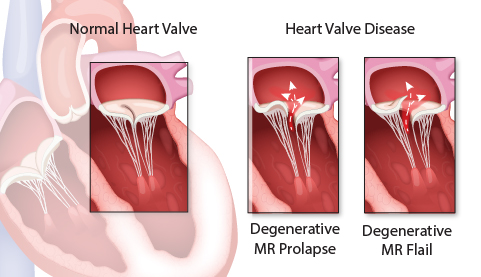 Your heart is an efficient muscle with the important job of pumping blood throughout your body. It has four valves – the mitral, aortic, tricuspid and pulmonary valves – and four chambers – the right and left atrium and the right and left ventricle. As the chambers pump blood, the valves open and allow blood to go where it needs to go.
Your heart is an efficient muscle with the important job of pumping blood throughout your body. It has four valves – the mitral, aortic, tricuspid and pulmonary valves – and four chambers – the right and left atrium and the right and left ventricle. As the chambers pump blood, the valves open and allow blood to go where it needs to go.
Heart valve disease can develop when:
- Your valves don’t allow enough blood through, often due to a narrowing, known as stenosis.
- Your valves don’t fully close and blood flows backward, known as regurgitation.
- Your valves don’t form correctly, which most often occurs at birth, known as atresia.
Aortic stenosis (when the aortic valve becomes blocked or narrowed due to calcium buildup) and mitral valve regurgitation (when blood leaks from the left ventricle back into the left atrium through the mitral valve) are two of the most common heart valve diseases.
Not everyone with heart valve disease has symptoms. However, when symptoms occur, they may include:
- Breathing problems, such as shortness of breath, difficulty breathing, having a hard time catching your breath and feeling winded after physical activity
- Chest pain or discomfort
- Fainting
- Feeling very lightheaded or dizzy
- Feeling very tired or weak
- Heart palpitations (when it seems your heart is skipping a beat or beating quickly)
- Swelling, particularly in your belly, ankles or feet
Some people are born with heart valve disease, but for most people, these conditions become more common with age. Your risk increases if you’ve had a heart attack, heart failure or an irregular heartbeat (arrhythmia). Rheumatic fever, an infection that can develop after strep throat, and endocarditis, an infection in the heart’s lining, can also increase the risk of heart valve disease.
Your first visit to the structural heart program at the UK Gill Heart & Vascular Institute will be a meeting that often takes only an hour. During this appointment, you will meet your care team, including:
- Your interventional cardiologist, a specialist who uses catheter-based procedures to diagnose and treat heart issues
- An advanced practice provider, (a physician assistant or nurse practitioner)
- A nurse coordinator
- A patient navigator, who works with you to help ensure that your healthcare needs are met
- If you need imaging, you will be scheduled for a follow-up visit at this time.
For the visit:
- Wear comfortable clothing.
- Bring your insurance information. While UK HealthCare accepts all insurers, not every insurer is in network.
- Bring a list of all medicines and supplements you currently take.
- You may find it helpful to have a family member or friend with you at this visit.
Where we are located
The UK Gill Heart & Vascular Institute is located at 800 Rose St. in Pavilion G, on the first floor of UK Albert B. Chandler Hospital. We will mail you a map and directions when your appointment is scheduled.
Patient drop-off
Patients can be dropped off in front of the main entrance to Albert B. Chandler Hospital at 1000 S. Limestone. If you are dropped off at the main entrance, you’ll enter the revolving doors on the ground floor of the hospital. Take the main stairs just to the left (or elevator across the atrium) to the first floor of Pavilion A.
After climbing the stairs or taking the elevator, turn left. You’ll pass the Kentucky Wall and Kentucky Children’s Hospital on your right. Continue to the end of the hall until it comes to a T shape. Turn left and the Gill clinic entrance is across from an open area housing the organ donor wall.
Parking
It is easiest to park in the UK HealthCare Parking Garage, across from the hospital at 110 Transcript Ave.
There are two paths from this garage to the Gill clinic:
- You may take the free shuttle from Level A of the parking garage. You’ll exit the shuttle at the Pavilion A/ Pavilion G stop in front of the main entrance to the hospital. After climbing the stairs or taking the elevator, turn left. You’ll pass the Kentucky Wall and Kentucky Children’s Hospital on your right. Continue to the end of the hall until it comes to a T shape. Turn left and the Gill clinic entrance is across from an open area housing the organ donor wall.
- From Level C of the parking garage you may walk or take a golf cart across the pedway to the first floor of Pavilion A. Turn left past the help desk and walk away from the dining hall. You’ll pass the Kentucky Wall and Kentucky Children’s Hospital on your right. Continue to the end of the hall until it comes to a T shape. Turn left and the Gill clinic entrance is across from an open area housing the organ donor wall.
If you need help finding your way, information desks are located inside the main entrances to Pavilion A, both on the ground floor and at the end of the pedway on the first floor. You may also call the information desk at 859-323-5816.
The UK Gill Heart & Vascular Institute’s structural heart program offers patients access to advanced clinical trials. Our Cardiology Clinical Research Center gives structural heart disease patients a chance to try new technologies years before they are available to the general public. These innovative and potentially lifesaving procedures are not available at other facilities in the region.









